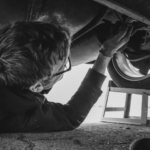Routine car maintenance service is something car owners can’t do without. Although most parts of the vehicle are crucial for its optimum functioning, one of these components is vital in terms of functionality and safety: the tires.
Your car tires have a critical impact on the handling, safety, and overall quality of your drive. Because of this, tires are a significant investment and should be treated with utmost care.
To help you with this, below are six car care tips that will ensure your tires remain safe and in good shape:
1. Check the Tire Pressure Every Month
Tires lose about one pound per square inch (PSI) of air every month and even more during cold weather months. This means that if you only rely on your mechanic to determine tire pressure during oil changes, you might be putting your safety on the road at risk.
You see, tires are designed to function their very best when pumped with the right PSI of air. Over-inflating can cause blowouts and premature wear, while under-inflating can lead to difficulty in steering and, in worse cases, road accidents.
To stay safe and extend the lifespan of your tires, check and maintain tire pressure every month. The ideal PSI for your tires should be indicated in the vehicle manual. In some models, it can also be found on a placard inside the vehicle door frame.
Use a tire gauge and add air, if necessary, to ensure that it is always at the optimum level, especially during long drives.
2. Inspect Tires Regularly
Aside from checking the air pressure inside the tires, it is also a good practice to do a periodic inspection on them. Even if you haven’t driven the vehicle for miles, tire inspection must be done at least once every month. This should also be performed before long trips to ensure that your tires can withstand the stress of an extended drive.
Among the things you should watch out for during a tire inspection are:
- Irregular or excessive tread wear
- Underinflation
- Bulges, scrapes, punctures, and cracks
If you find any one of these or if you suspect the loss of air pressure, dismount the tires and have them inspected for any damage by a trained tire expert, so issues can be addressed accordingly.
3. Check Tire Tread Depth
Checking the tire tread depth is an excellent way to determine the efficacy of your tires. To check the tread depth, you can try the penny method. This entails determining whether the tire is still within the ideal 2/32-inch threshold.
To perform the penny method, follow the steps below:
- Put the coin between the tire tread ribs (the raised tread portion spanning the tire circumference). One tire tread consists of several ribs.
- Turn the coin so that the head is pointing down into the tread.
- Check if the top of the head on the coin disappears between as it goes deeper into the ribs. If it still does, your tread remains above the 2/32” threshold. If the entire head is visible, it may be high time that you replace your tire as the tread is no longer deep enough.
If you have one, you can also use a treadwear indicator to see if your tires are still roadworthy. Check if the indicator shows the tire within the said threshold, measured from the bottom of the groove. If it’s below this level, then it is time to change your tires.
Aside from keeping the tires safe for a drive, knowing the tire tread depth also helps you check for four different issues, depending on the appearance of tread wear:
- Underinflation – Tires are worn out along the outer edges
- Overinflation – Tires are worn out in the center
- Worn parts of the vehicle – Tread shows dips or cups (commonly for front tires, but also possible for rear tires)
- Tire misalignment – Tires have sawtooth edges due to erratic scrubbing against the road
4. Keep Tires Aligned
Aside from inflation and tread, another thing that needs to be maintained is the tire alignment. The front tires require regular alignment to ensure that there’s no excessive amount of difference in the way these tires are pointing, which can cause undue and excessive wear.
To do so, make sure to bring the vehicle to a qualified and reputable car maintenance workshop near you. They should be able to measure the tow out and tow in of the wheels and make the necessary adjustments based on the manufacturer’s recommendations.
5. Rotate the Tires Often
Tire rotation ensures that the tires – both front and rear – get an even wear and potentially extend their lifespan. Depending on where the tire is placed and other factors, it may show different tread wear patterns.
Because of cornering, front tires may show more wear along the edges than tires placed at the back of the vehicle. Tires mounted on the drive wheels often get additional wear due to acceleration.
6. Prevent Dry Rotting
Visually evident sidewall weathering often occurs when rubber compounds in the tire start to break down. This natural degradation process occurs over time and is due to tire exposure to adverse environmental conditions. This phenomenon is called “dry rotting.”
Signs of dry rot tires include a breakable appearance, discoloration, and tire tread and sidewall cracks. When the deterioration starts to become obvious, tire replacement is your best option to prevent further damage.
Once you’ve replaced the tires, remember to prevent dry rot tires by:
- Parking out of direct sunlight as much as possible, especially for extended periods;
- Avoiding harsh chemicals when using tire protectants and cleaners;
- Ensuring proper tire inflation;
- Following maximum capacity limits;
- Ensuring proper tire storage and care; and
- Bringing your vehicle to authorized Audi workshops for routine maintenance and inspection.
Well-Maintained Tires for Safe Travels
Safety and the overall quality of a drive are affected by many vehicular components and factors. Among these, the tires have a significant role because they carry the vehicle’s entire weight.
Make sure that your travels are as safe as possible by using this article as a guide in taking care of your tires.
AUTHOR BIO
Ahmad Ramadan is a Managing Partner at Deutsche Technik Service Center, Dubai’s first and largest VW, Audi, Mercedes, Bentley, Porsche, & Lamborghini vehicle specialist and performance tuner. DT has also built an illustrious portfolio in classic car repair, maintenance, and restoration, as well as body work (accident repair, painting, and denting). DT Service Centre offers a full range of services: mechanical repairs, maintenance, servicing, etc.





